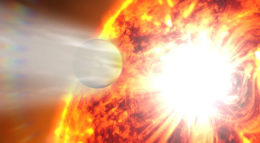It’s nearly eight billion years in the future.
The Sun, having exhausted its source of fuel, has dramatically expanded into a red giant and then puffed off its outer layers, leaving its dense, scalding hot core exposed. This core — a white dwarf — initially clocks in at nearly 100,000 K (180,000 °F), bathing its surroundings in harsh extreme-ultraviolet (EUV) radiation at levels that are up to a million times brighter than the present-day Sun.
Earth and the other inner, rocky planets were swallowed up by the ballooning Sun long ago. But how have the giant planets of our solar system — Jupiter, Saturn, Uranus, and Neptune — fared since this unavoidable apocalypse?
A Hostile Environment

Artist’s impression of a close-in hot Jupiter being evaporated by its nearby host. Giant planets on much longer orbits can be evaporated at similar rates by the extreme ultraviolet radiation of a white dwarf. [NASA’s Goddard SFC]
Through a series of calculations, Schreiber and collaborators show that giant planets in a solar system like ours — even with their large orbital distances — will lose mass while orbiting a solar white dwarf at a rate that’s comparable to that measured for short-period hot Jupiters and warm Neptunes orbiting ordinary stars.
Signatures of Pollution
How will future aliens be able to spot this evaporation of our solar system’s giant planets?
When left alone, white dwarfs usually have pristine outer layers of hydrogen and helium, because heavier elements rapidly sink to the stars’ centers under the strong gravity. If we observe signatures of metals in a white dwarf’s spectrum, therefore, this is likely a sign that the star recently accreted debris from its environment — perhaps from the evaporated atmosphere of a distant gas giant.
Schreiber and collaborators demonstrate that a fraction of the evaporated material from giant planets in our solar system will accrete onto the Sun-turned-white-dwarf, polluting its outer layers at a level that can be detected with optical and ultraviolet spectroscopy for millions of years. Alien scientists could therefore observe these signatures and determine the composition of the outer atmospheres of our giant planets.
Glimpsing Our Future

There is good agreement between prediction (orange) and observation (blue) for pollution abundances in hot white dwarf atmospheres, for white dwarfs of different temperatures. The predictions assume a giant planet occurrence rate of 65%. [Schreiber et al. 2019]
About a third of the hot white dwarfs we’ve observed with adequate ultraviolet spectroscopy show signs of polluting volatiles — and the amount of polluting material is hotter for hotter white dwarfs. Schreiber and collaborators use a population model to show that the observed numbers and trends are beautifully consistent with the pollution being caused by evaporated material from giant planets, assuming that at least 50% of hot white dwarfs host at least one giant planet.
Soon, we’ll be able to use more detailed models and observations of these systems to better understand the composition of the evaporated planets — but in the meantime, we can enjoy this insightful glimpse into our solar system’s future.
Citation
“Cold Giant Planets Evaporated by Hot White Dwarfs,” Matthias R. Schreiber et al 2019 ApJL 887 L4. doi:10.3847/2041-8213/ab42e2
